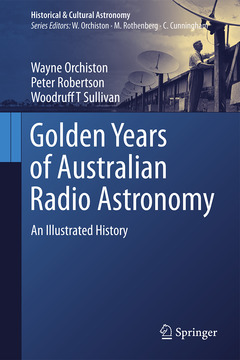Description
Golden Years of Australian Radio Astronomy, 1st ed. 2021
An Illustrated History
Historical & Cultural Astronomy Series
Authors: Orchiston Wayne, Robertson Peter, Sullivan III Woodruff T.
Language: English
Subject for Golden Years of Australian Radio Astronomy:
Keywords
Open Access; History of radio astronomy; CSIRO Radiophysics Laboratory; John Bolton; Taffy Bowen; Chris Christiansen; Discrete radio sources; Field stations; Hydrogen-line studies; Frank Kerr; Mills Cross; Bernie Mills; Parkes Radio Telescope; Joe Pawsey; Ruby Payne-Scott; Radio source surveys; Radioheliograph; Sea interferometers; Alex Shain; Solar bursts and eclipses
52.74 €
In Print (Delivery period: 15 days).
Add to cart268 p. · 15.5x23.5 cm · Hardback
Description
/li>Biography
/li>Comment
/li>
The evolution of Australian radio astronomy from 1945 to 1960 has been studied in detail by numerous historians of science in recent years. This Open Access book is the first to present an overview of this remarkable chapter in Australian science.
The book begins in the post-war period, as the Radiophysics Laboratory in Sydney switched from secret wartime research on radar to peacetime applications of this new technology. Next follows the detection of radio waves from space and the ensuing transformation of this fledgling science into the dominant research program at the Radiophysics Lab. Drawing from this history, the book shows how by 1960 the Radiophysics Lab had become the largest and most successful radio astronomy group in the world. The final chapter presents an overview of Australian radio astronomy from 1960 to the present day, as Australia prepares to co-host the multi-national, multi-billion-dollar Square Kilometre Array.
Nearly 300 high-quality images complement the text, drawn from a wide range of sources including the extensive collection held by the CSIRO Radio Astronomy Image Archive. The book will be an essential reference for readers interested in the scientific and cultural development of radio astronomy.
This book is published open access under a CC BY 4.0 license.
Prof Wayne Orchiston works at the National Astronomical Research Institute of Thailand and is an Adjunct Professor in the Astrophysics Group at the University of Southern Queensland (USQ) in Toowoomba, Australia. Previously, he worked in academic and government astronomy posts in Australia and New Zealand. Wayne has a special interest in the history of astronomy, and through Western Sydney University, James Cook University (Townsville, Australia) and USQ has supervised the research of more than 30 PhD and Masters theses. He has published papers about early radio astronomy (in Australia, France, India, Japan, New Zealand and the USA); the history of cometary astronomy and meteoritics; historic transits of Venus and solar eclipses; early developments in astrophysics; historic telescopes and observatories; and ethnoastronomy. His recent books include Eclipses, Transits and Comets of the Nineteenth Century: How America’s Perception of the Sky Changed (Springer, 2015, co-authored by Stella Cottam), Exploring the History of New Zealand Astronomy: Trials, Tribulations, Telescopes and Transits (Springer, 2016), John Tebbutt: Rebuilding and Strengthening the Foundations of Australian Astronomy (Springer, 2017) and The Emergence of Astrophysics in Asia: Opening a New Window on the Universe (Springer, 2017, co-edited by Tsuko Nakamura). Currently Wayne is the President of IAU Commission C3 (History of Astronomy), and in 2003 he founded the IAU Working Group on Historic Radio Astronomy. In 1998 he and John Perdrix launched the Journal of Astronomical History and Heritage, and he is the current Editor. Wayne is also a Co-Editor of Springer’s Historical & Cultural Astronomy Series. In 2013, the IAU named minor planet 48471 Orchiston after him.
Dr Peter Robertson is an honorary research fellow in the School of Physics, University of Melbourne. He spent most of his career as managing editor of the Australian Journal of Physi




